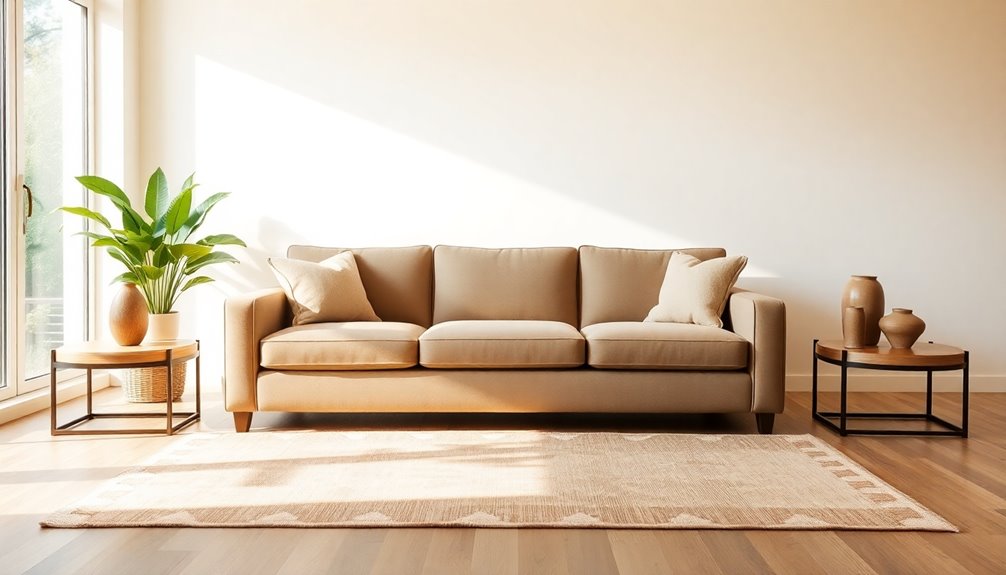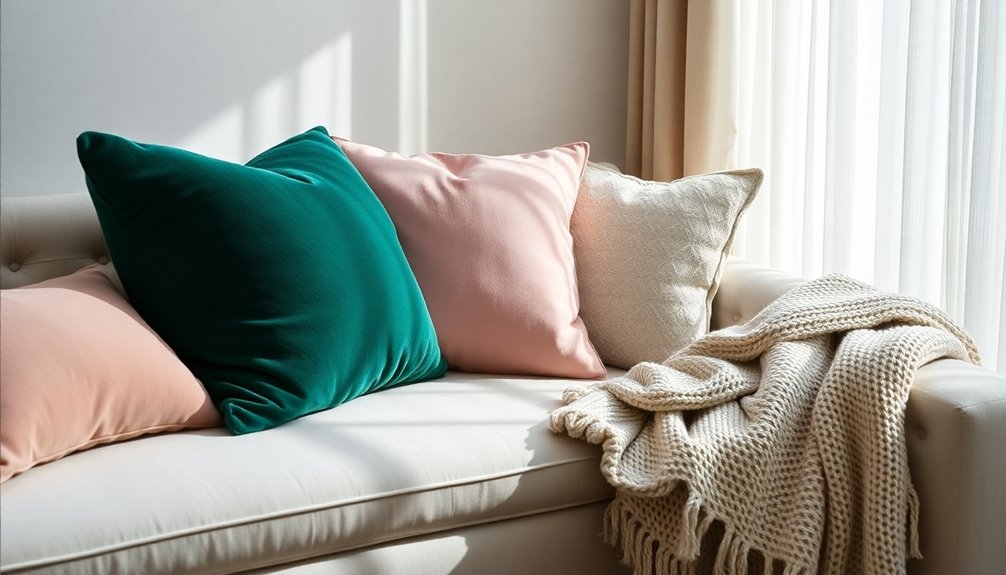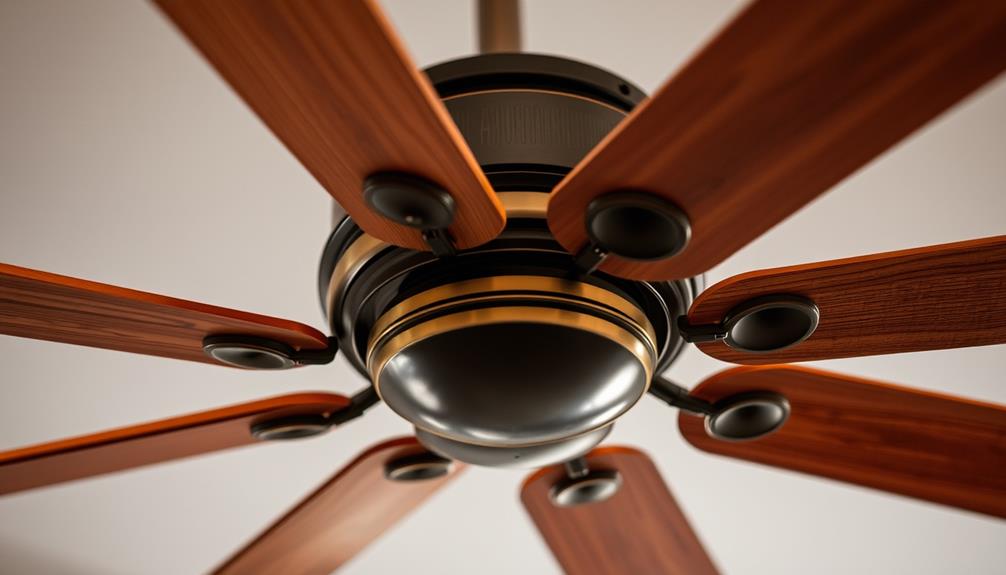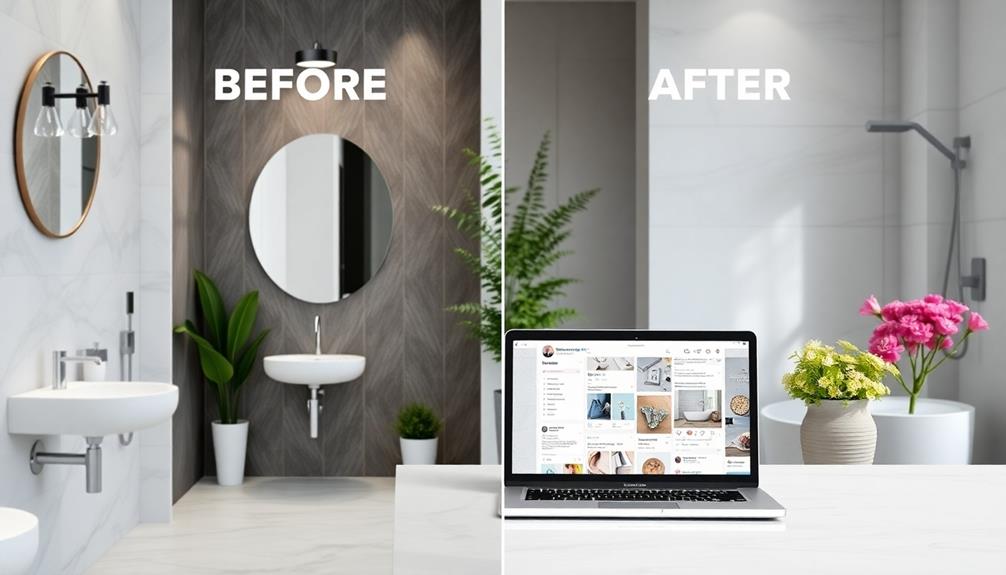To place your sofa in the living room, position it to face a focal point, like a TV or fireplace, ensuring it encourages conversation. Keep pathways clear by leaving 24-36 inches around and avoiding overcrowding. If your space is large, consider a sectional sofa for balance; smaller rooms benefit from compact designs. Use angles to create dynamic layouts, steering clear of rigid lines. Finally, maintain good lighting by placing the sofa near natural light sources or lamps, ensuring a warm atmosphere. There's more to explore about optimizing your living space for comfort and style.
Key Takeaways
- Position the sofa to face a focal point, such as a TV or fireplace, for an inviting atmosphere.
- Create a flow by leaving 24-36 inches for pathways around the sofa and other furniture.
- Use angles in placement for a dynamic layout, avoiding rigid lines that can make the space feel cramped.
- Group the sofa with chairs to establish conversation areas, enhancing social interaction in the room.
- Scale the sofa size to fit the dimensions of the living room, ensuring it complements the space without overcrowding.
Introduction
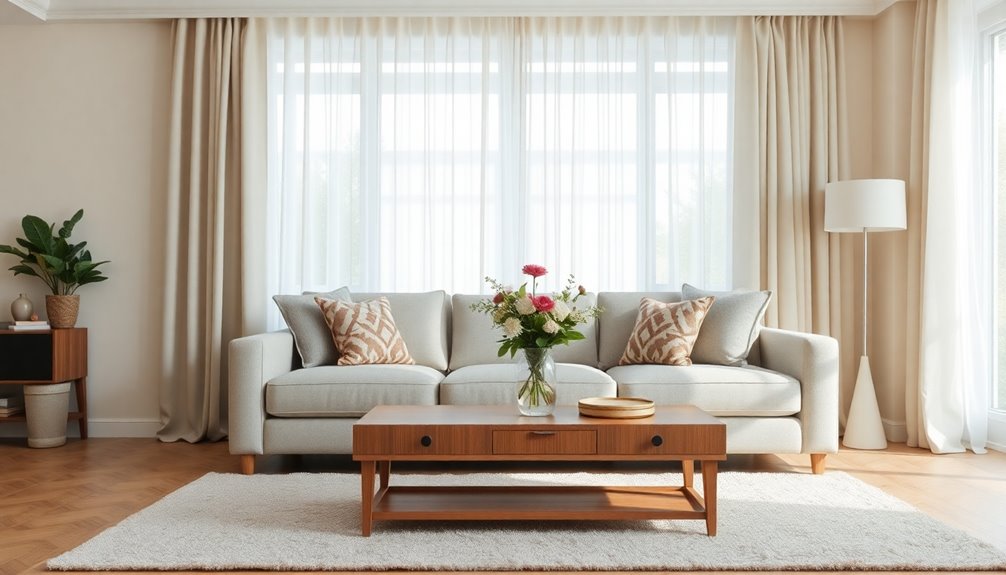
Keeping your sofa clean is just as important as placing it perfectly in your living room. You'll want to establish a routine for dusting and vacuuming, and learn the right fabric-specific cleaning techniques. Plus, knowing how to tackle tough stains like wine and grease can help maintain your sofa's appearance for years to come.
Routine Dusting and Vacuuming
To ensure your living room remains a clean and inviting space, routine dusting and vacuuming around your sofa are essential. Regular dusting of surfaces near your sofa helps prevent dust accumulation, which improves indoor air quality and reduces allergens in your living space. Use a microfiber cloth or a soft-bristled brush for dusting to avoid scratching or damaging delicate surfaces and upholstery.
Make vacuuming a key part of your cleaning schedule. Aim to vacuum the sofa itself, including cushions and crevices, at least once a week to remove hidden dirt, pet hair, and debris. This not only extends the life of your upholstery but also maintains the overall appearance of your living room. Don't forget to vacuum beneath and around the sofa, as these areas often collect dust and particles that can affect cleanliness.
Fabric-Specific Cleaning Techniques
When it comes to maintaining your fabric sofa, knowing the right cleaning techniques is essential for preserving its beauty and longevity. Always start by checking the cleaning tag, as it provides crucial instructions. Codes like "W" indicate you can use water-based cleaners, while "S" suggests solvent-based options. If you see "WS," both are safe, and "X" means professional cleaning is necessary.
Regular vacuuming with an upholstery attachment helps prevent dirt buildup and keeps your fabric sofas looking fresh. When spills occur, immediate spot cleaning with a damp cloth can stop stains from setting in. For deeper cleaning on water-safe fabrics, mix mild soap with water, but be careful not to soak the fabric to avoid water damage.
If you opt for solvent-based cleaners, always test them on a hidden area first. This step ensures they won't discolor or damage your sofa. To enhance the longevity of your fabric sofa, consider applying fabric protectors. These products repel stains and liquids, making future cleaning much easier. By following these techniques, you can keep your fabric sofa in top shape for years to come.
Tackling Wine and Grease Stains
Even with careful cleaning, accidents can happen, and wine or grease stains may find their way onto your fabric sofa. When dealing with wine stains, act quickly. Blot the area with a clean, dry cloth to absorb excess liquid, then treat it with a mixture of dish soap and hydrogen peroxide. This effective cleaning solution can help lift the stain without damaging your upholstery.
For grease stains, sprinkle baking soda or cornstarch on the spot and let it sit for 15-30 minutes to absorb the grease. Afterward, vacuum it up and follow up with a mild dish soap solution for further stain removal. Always test any cleaning solution on an inconspicuous area of your fabric first to avoid discoloration.
Using a soft-bristle brush can also be beneficial. It helps work the cleaning solution into the fibers of textured upholstery without causing damage. If you find that stains persist despite your efforts, don't hesitate to seek professional upholstery cleaning. This ensures thorough treatment, leaving your sofa looking fresh and clean without risking further damage. Additionally, maintaining regular grooming can significantly reduce the amount of pet hair that transfers to your furniture, making cleaning easier overall.
Avoid Direct Sunlight Exposure
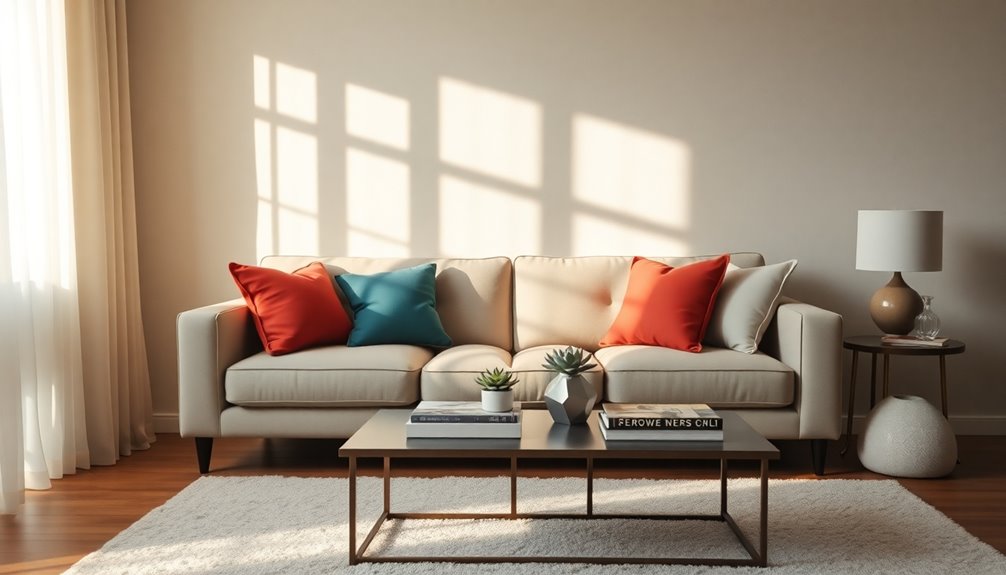
To keep your sofa looking great, it's essential to choose fabrics that can handle sun exposure. Opt for pet-friendly and textured materials, as they not only resist fading but also stand up to everyday wear and tear. You might also consider using fabric protectors to add an extra layer of defense against sunlight and spills.
Pet-Friendly Fabric Choices
Choosing the right fabric for your sofa is crucial, especially if you have pets that can be tough on furniture. Opt for synthetic fabrics like microfiber and polyester. These materials are durable, stain-resistant, and easy to clean, making them ideal for homes with furry friends. You'll also want to consider darker colors or patterns, as they help conceal pet hair and stains better than lighter fabrics.
Look for fabrics with tight weaves, such as canvas or denim, which resist snags from pet claws. Avoid materials like silk or velvet, as they can easily get damaged. Instead, think about outdoor fabrics that offer UV protection and resist fading from sunlight. This way, your sofa will maintain its look even in a bright room. Additionally, investing in high-quality upholstery can enhance the longevity of your sofa while providing comfort for both you and your pets.
Incorporating slipcovers made of pet-friendly fabrics adds an extra layer of protection against wear and tear. They can be easily removed and washed, keeping your sofa looking fresh and clean. By choosing the right fabric and protective measures, you can ensure your living room remains stylish and pet-friendly.
Textured Fabric Protection Options
When selecting a sofa with textured fabric, protecting it from direct sunlight is key to maintaining its appearance and longevity. Start by using window treatments like blinds or curtains to minimize sunlight exposure, which can lead to fading and degradation of your textured fabrics. Consider your sofa placement carefully; positioning it away from windows reduces the risk of heat damage and discoloration over time.
You might also want to invest in slipcovers made from UV-resistant materials. These can shield the underlying fabric while being easy to remove and wash. Additionally, applying fabric protectants specifically designed for textured fabrics can create a barrier against harmful UV rays, helping to maintain the fabric's integrity.
Don't forget to regularly rotate your cushions and throws to ensure even wear and exposure to sunlight. This simple practice can prolong the lifespan of your sofa's textured fabric, keeping it looking fresh and vibrant. By taking these steps, you can enjoy your beautiful sofa without worrying about the damaging effects of sunlight.
Using Fabric Protectors
Protecting your sofa from UV rays is essential for preserving its color and fabric quality, especially in sunlit areas. Direct sunlight exposure can cause fading and deterioration of your upholstery over time. To maintain the integrity of your sofa, avoid placing it directly in front of windows. Instead, consider strategic placement in your living room that minimizes exposure to harsh sunlight.
Consider using fabric protectors designed to shield your cushions and upholstery from UV damage. Fabrics like solution-dyed acrylic or polyester not only enhance durability but also resist fading from sun exposure. Additionally, window treatments like curtains or blinds can diffuse sunlight, providing an extra layer of protection for your sofa.
Regularly rotating cushions and throws helps ensure even wear and prevents uneven fading caused by sunlight. This simple habit promotes a more uniform appearance over time. By implementing these strategies, you can maintain the beauty and longevity of your sofa while enjoying the natural light in your living room. Remember, thoughtful placement and the right materials are key to protecting your investment in your home's comfort and style.
Upholstery Seam Reinforcement
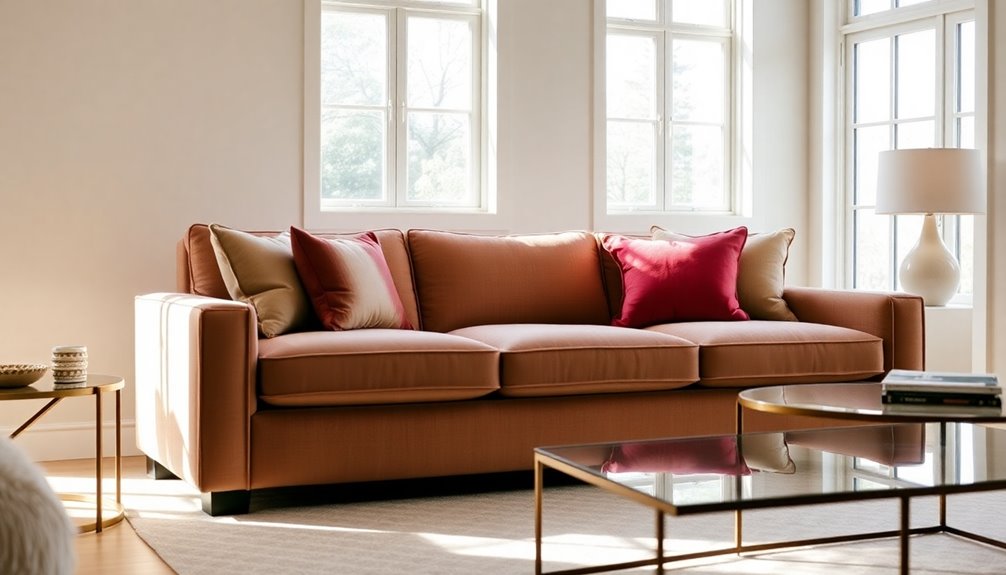
When you're considering upholstery seam reinforcement, keep in mind how frame integrity can affect overall durability. Don't forget about leather conditioning treatments and cushion fluffing techniques, as these can also play a vital role in maintaining your sofa's appearance and longevity. By addressing these aspects, you'll ensure your furniture remains both functional and stylish for years to come.
Frame Integrity Concerns
Upholstery seam reinforcement plays a vital role in ensuring your sofa maintains its structural integrity over time. When you invest in a sofa, you want it to withstand wear and tear while providing comfort and style. Proper seam construction techniques, like double stitching or using heavy-duty thread, enhance the durability of upholstery seams, preventing fraying or splitting at stress points during regular use.
Reinforced seams not only boost the overall lifespan of your sofa but can also keep it looking great for 10-15 years or more with proper care. Incorporating interlining materials between upholstery layers offers additional support and stability, further protecting against potential issues.
To maintain frame integrity, it's crucial to conduct regular inspections of your upholstery seams. This proactive approach helps identify any problems early, allowing for timely repairs that can extend your sofa's life. By prioritizing seam reinforcement and being attentive to its condition, you can ensure your sofa remains a valuable centerpiece in your living room for years to come. Remember, a well-maintained sofa is not just about aesthetics; it's about preserving its quality and functionality.
Leather Conditioning Treatments
Regular leather conditioning treatments are crucial for keeping your leather sofa looking and feeling its best. These treatments help maintain the suppleness and longevity of leather upholstery, preventing it from drying out and cracking over time. Aim for regular conditioning every 6 to 12 months to nourish the leather, restoring its natural oils and enhancing its resistance to wear and tear.
When selecting a conditioner, always choose a pH-balanced leather product free from harsh chemicals, as these can degrade the leather and compromise its integrity. Before applying the conditioning treatments, test a small, inconspicuous area first to ensure compatibility with your leather type and avoid any discoloration.
In addition to conditioning, consider upholstery seam reinforcement to enhance durability. Using specialized leather adhesives or stitching techniques can prevent seams from splitting, which is essential for maintaining the overall look and functionality of your sofa. By combining regular conditioning with careful seam reinforcement, you'll ensure that your leather sofa remains a stunning centerpiece in your living room for years to come. This approach aligns with the art of decluttering strategies to create a peaceful living environment, emphasizing the importance of maintaining quality items.
Cushion Fluffing Techniques
Fluffing cushions is essential for maintaining their shape and comfort, helping you avoid sagging and wear over time. Regularly push the corners and sides of your cushions inward with your hands to keep them full and supportive. For upholstery seam reinforcement, use a sewing machine with heavy-duty thread to stitch along the seams, enhancing durability and preventing splits.
Consider adding extra padding, like foam inserts or batting, inside the cushion covers. This not only improves comfort but also provides additional support, reinforcing the seams for longer-lasting use.
When cleaning your cushions, steer clear of harsh chemicals that can weaken the fabric and seams. Instead, opt for mild detergents and gentle washing methods to maintain their integrity. It's also crucial to conduct regular inspections of your cushions and seams for any signs of wear or damage. Addressing these issues promptly will prolong the lifespan of your upholstery and ensure continued comfort. With consistent maintenance and care, your cushions will remain inviting and supportive, enhancing the overall atmosphere of your living space. Additionally, implementing lighting design can further elevate the comfort and aesthetic of your living room.
Personalized Fabric Choices
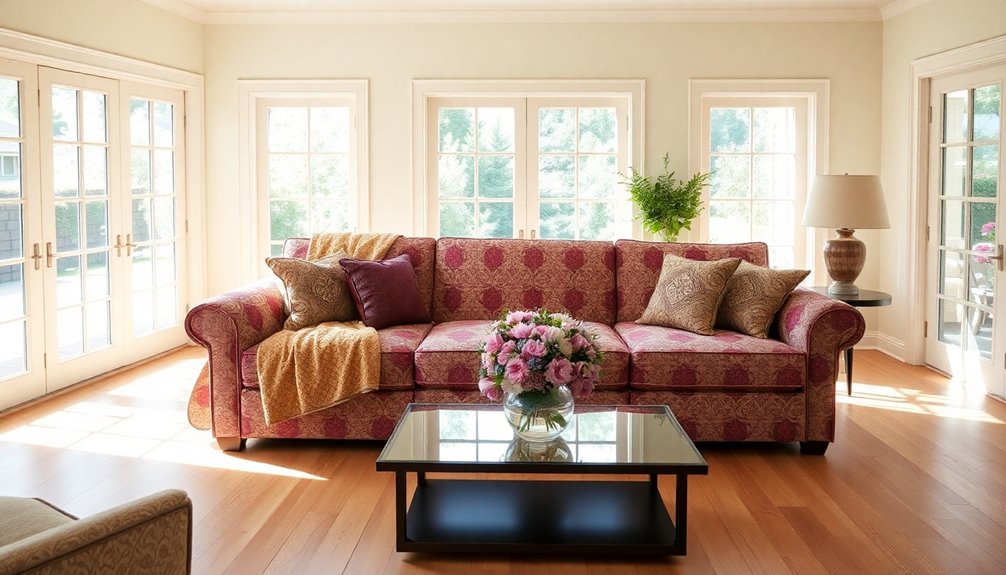
Choosing the right fabric for your sofa can transform your living room's vibe and functionality. When selecting upholstery, prioritize durability, especially if your space is high-traffic. Materials like leather and microfiber are excellent choices, known for their resilience and ease of cleaning. Aim for fabrics with a minimum of 30,000 double rubs on the Martindale test to ensure longevity.
Color and pattern are equally important. Light colors can make your living room feel more spacious, while bold patterns can serve as captivating focal points, adding personality to your space. Think about how these choices reflect your style and the atmosphere you want to create.
Texture also plays a crucial role. Plush fabrics like velvet offer a cozy, inviting feel, perfect for relaxation, while smooth materials such as canvas can contribute to a sleek, modern aesthetic. Keep in mind that natural fibers like cotton and linen are breathable and comfortable but might require more maintenance than synthetic blends that provide stain resistance and easy upkeep.
Seasonal Fabric Maintenance Tips
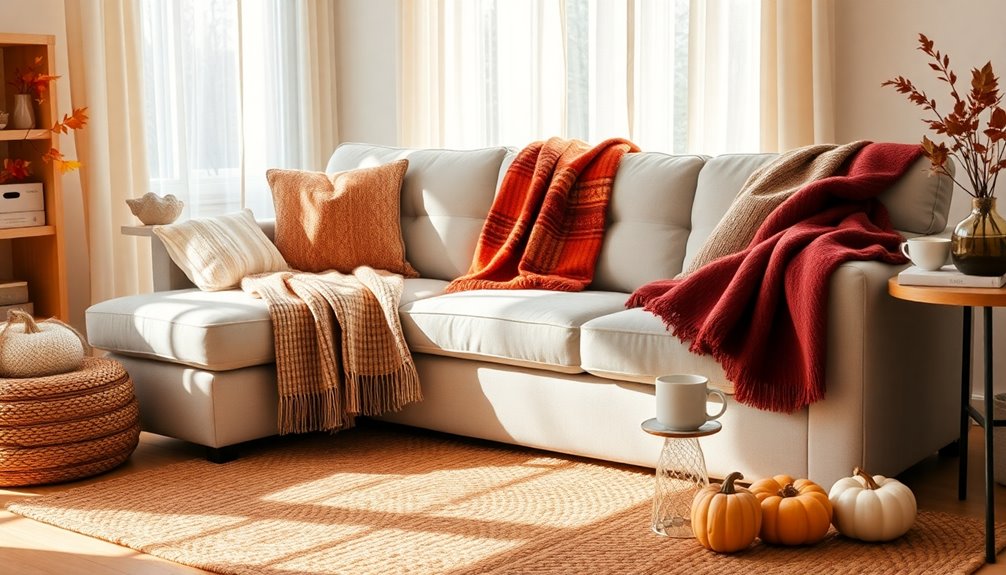
Maintaining your sofa's fabric is essential for keeping it looking fresh and vibrant throughout the seasons. Start by regularly vacuuming your sofa with an upholstery attachment, ideally once a week. This routine cleaning helps remove dust and debris, maintaining the fabric's appearance and hygiene. For seasonal cleaning, use a fabric-specific cleaner to spot clean any stains, but make sure you test it on an inconspicuous area first to avoid discoloration.
Don't forget to rotate and fluff your cushions every few weeks. This practice helps maintain their shape and prevents uneven wear, especially in the areas you use most. To protect your sofa from sun damage, consider using window treatments or UV-filtering films. Prolonged exposure to sunlight can fade colors and weaken fabrics over time.
Additionally, applying a fabric protector spray every few months can repel spills and stains, enhancing the longevity of your upholstery. This makes future cleanings easier and helps keep your sofa looking its best through every season. By following these seasonal fabric maintenance tips, you can ensure your sofa remains a beautiful focal point in your living room for years to come.
Conclusion
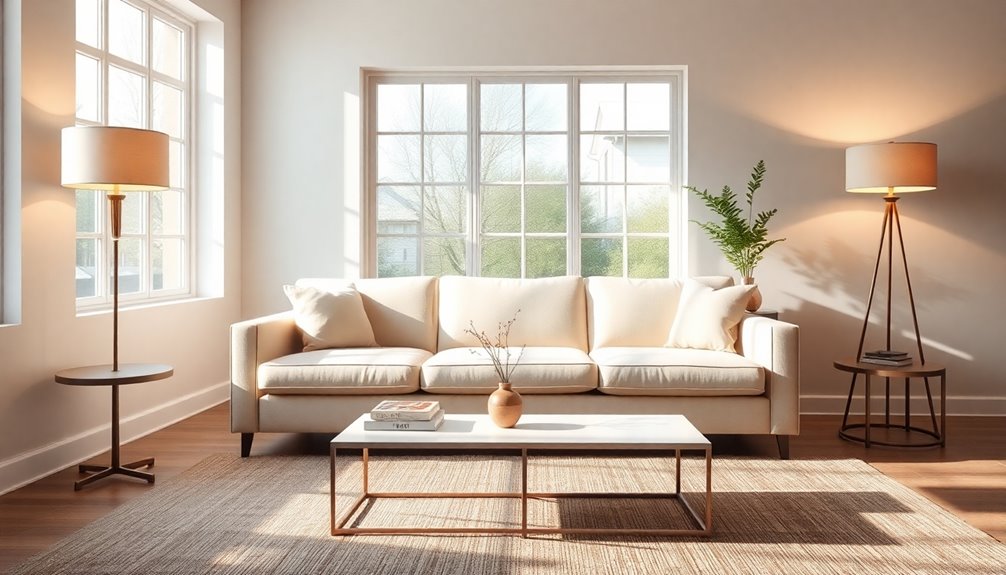
Placing your sofa thoughtfully in the living room can transform the space into a warm and inviting environment. By positioning your sofa to face the room's focal point, such as a fireplace or TV, you enhance functionality while creating a cohesive design. Aim for a clearance of at least 18 inches between the sofa and coffee table to ensure easy movement and accessibility.
If you have a smaller living room, consider flanking the sofa with chairs to maintain a comfortable seating area without sacrificing traffic flow. This arrangement allows for better movement around the space while maximizing seating capacity. Angling the sofa can also create a dynamic layout, encouraging conversation and making the area feel more welcoming.
Utilizing area rugs can further define your conversation area, ensuring that at least the front legs of your sofa rest on the rug for visual cohesion and comfort. Thoughtful furniture placement not only enhances the aesthetic appeal of your living room but also creates a space where friends and family can gather and enjoy each other's company. With these strategies in mind, you can create an inviting atmosphere that fits your lifestyle perfectly.
Frequently Asked Questions
How Should Sofa Be Placed in Living Room?
When you’re thinking about how to position your sofa, focus on creating a welcoming environment. Aim to face it towards a focal point like a fireplace or TV. Keep at least 18 inches between the sofa and coffee table for easy movement. Avoid pushing it against walls; instead, pull it slightly forward to improve traffic flow. Use area rugs to define seating areas, ensuring the space feels cohesive and inviting. Consider adding accent chairs or ottomans to enhance the seating arrangement and encourage conversation. When arranging cushions on corner sofas, play with different sizes and textures to create visual interest and comfort. Additionally, make sure to leave enough space for side tables, providing a convenient spot for beverages and decorative items, further enhancing the cozy atmosphere of your living area.
Where Is the Best Place to Put a Sofa in the Living Room?
When figuring out the best place to put your sofa in the living room, think about the room's focal point. You want your sofa facing that area, whether it's a fireplace or a TV, to encourage interaction. If space is tight, consider pushing it against a wall. For bigger rooms, floating it can create cozy conversation zones. Just make sure you leave enough clearance for easy movement and access!
What Is the 2/3 Rule for Sofas?
The 2/3 Rule for sofas suggests your sofa should be about two-thirds the length of the wall it's against. This keeps your space balanced and visually appealing, preventing the sofa from overwhelming the room. When you apply this rule, think about the room layout and the placement of other furniture to ensure everything flows well together. While it's a helpful guideline, don't forget to consider your personal style and the room's unique dimensions.
Should the Couch Be Against the Window?
You might want to think twice before placing your couch against the window. While it can create a cozy nook, it can also block natural light, making your space feel darker. If you decide to go this route, try leaving a 10-12 inch gap for airflow and to protect the fabric from sunlight. Consider light-diffusing window treatments to maintain privacy while still enjoying the view. Balance is key for both aesthetics and comfort!
